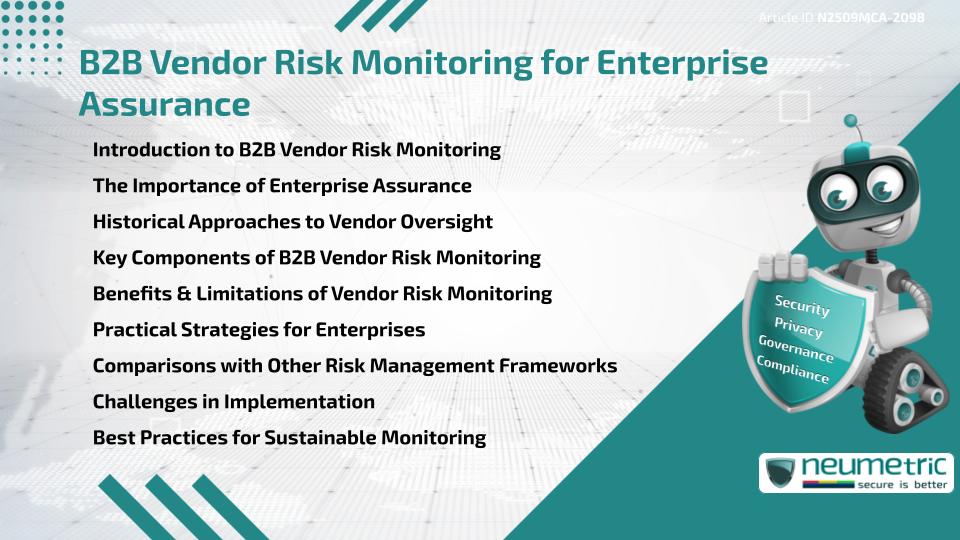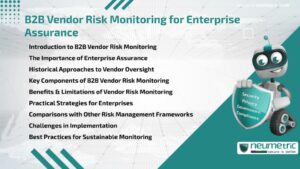Table of Contents
ToggleIntroduction to B2B Vendor Risk Monitoring
B2B Vendor Risk Monitoring is the process of continuously assessing & managing Risks that arise from Third Party Vendors in order to safeguard Enterprise operations. Enterprises depend on multiple suppliers & partners, which increases exposure to Financial, Operational, Security & Compliance Risks. Monitoring ensures that Vendors align with organisational standards, regulatory obligations & strategic goals. Effective B2B Vendor Risk Monitoring provides a foundation for Enterprise Assurance by building resilience, trust & operational reliability.
The Importance of Enterprise Assurance
Enterprise Assurance refers to the confidence Stakeholders have in an organisation’s ability to operate securely, ethically & effectively. Vendors often have access to Sensitive Systems, Customer Data & Critical Supply Chains. Any Vendor failure can quickly undermine Enterprise Assurance. For example, a Security Breach at a supplier could expose Confidential information, while a lapse in Compliance could lead to regulatory penalties. By embedding B2B Vendor Risk Monitoring into daily processes, Organisations safeguard their brand reputation & strengthen Business Continuity.
Historical Approaches to Vendor Oversight
Historically, Vendor oversight was limited to annual Audits & contractual Compliance checks. These reactive methods often identified Risks only after issues had already occurred. With Globalisation & Digital Transformation, the complexity of Vendor ecosystems expanded dramatically. A single Enterprise might rely on hundreds of Vendors across different regions. This created the need for proactive, Continuous Monitoring rather than periodic Reviews. Modern B2B Vendor Risk Monitoring evolved to address these challenges through Automation, Risk scoring & Real-time alerts.
Key Components of B2B Vendor Risk Monitoring
Effective monitoring relies on several components:
- Risk Identification: Mapping Vendors to potential Risks such as Cybersecurity, Regulatory, Financial & Operational exposure.
- Risk Assessment: Assigning scores or categories to Vendors based on their Likelihood & Impact of failure.
- Continuous Monitoring: Using tools to track changes in Vendor performance, Compliance status & Security posture.
- Remediation & Response: Establishing Protocols for addressing identified Risks before they escalate.
- Reporting & Governance: Providing management with regular updates for Transparency & Accountability.
These components work together to create a cycle of assurance where issues are spotted & addressed early.
Benefits & Limitations of Vendor Risk Monitoring
The primary benefit of B2B Vendor Risk Monitoring is enhanced protection against unexpected disruptions. It enables Enterprises to reduce the chances of Financial loss, regulatory penalties & reputational damage. It also strengthens relationships with Vendors by creating a culture of Accountability.
However, limitations exist. Monitoring requires significant investment in technology, expertise & time. Over-monitoring can strain Vendor relationships, while under-monitoring leaves Gaps. Additionally, no system can predict every Risk with absolute certainty. These trade-offs highlight the importance of balanced & adaptive approaches.
Practical Strategies for Enterprises
Enterprises can adopt practical strategies to optimise Vendor Risk monitoring:
- Prioritise Vendors based on criticality & potential impact.
- Integrate monitoring into Procurement & Vendor onboarding processes.
- Use external data sources such as Regulatory watchlists or Cybersecurity ratings.
- Foster transparent communication with Vendors to encourage proactive disclosure.
- Regularly train staff on recognising & managing Vendor-related Risks.
These strategies make monitoring less of a Compliance exercise & more of a value-adding process.
Comparisons with Other Risk Management Frameworks
B2B Vendor Risk Monitoring shares similarities with broader frameworks such as Enterprise Risk Management [ERM] & Information Security Management Systems [ISMS]. While ERM looks at Risk across the entire Organisation, Vendor Risk monitoring narrows the focus to third parties. ISMS frameworks such as ISO 27001 emphasise Information Security but may not fully capture Financial or operational Vendor Risks. By combining Vendor monitoring with these frameworks, Enterprises create a layered approach that enhances assurance.
Challenges in Implementation
Despite its importance, Organisations face challenges when implementing monitoring. These include resistance from Vendors who view oversight as intrusive, difficulty in collecting accurate real-time data & managing large volumes of Vendor information. Smaller Enterprises may also lack resources for advanced monitoring systems. Overcoming these challenges requires leadership commitment, phased rollouts & leveraging Third Party platforms to reduce manual workload.
Best Practices for Sustainable Monitoring
For sustainability, Enterprises should adopt Best Practices such as:
- Establishing clear Vendor Risk Policies aligned with business goals.
- Automating monitoring wherever possible to reduce human error.
- Periodically reviewing Vendor portfolios to re-prioritise based on evolving Risks.
- Collaborating with Vendors through joint Risk workshops.
- Ensuring monitoring is not just reactive but also predictive.
These Best Practices transform Vendor monitoring into a Continuous Improvement process that enhances Enterprise Assurance.
Conclusion
B2B Vendor Risk Monitoring is essential for Enterprises that rely on complex Vendor networks. It enables proactive identification & management of Risks, creating stronger resilience & confidence in operations. While challenges exist, adopting structured strategies & Best Practices ensures long-term effectiveness.
Takeaways
- Continuous Monitoring is more effective than periodic Audits.
- Enterprise Assurance depends on Vendor Trustworthiness.
- Balanced approaches help overcome limitations of monitoring.
- Practical strategies include prioritisation, integration & automation.
- Best Practices emphasise sustainability & collaboration with Vendors.
FAQ
What is B2B Vendor Risk Monitoring?
It is the process of continuously assessing & managing Risks associated with Third Party Vendors to protect Enterprise operations & assurance.
Why is B2B Vendor Risk Monitoring important for Enterprises?
It ensures that Vendors do not introduce Financial, Operational or Compliance Risks that could harm Enterprise stability & reputation.
How does Vendor Risk monitoring differ from Enterprise Risk Management?
Vendor Risk monitoring focuses specifically on third parties, while Enterprise Risk Management addresses Risks across all organisational functions.
What challenges do Enterprises face in implementing monitoring?
Common challenges include Vendor resistance, lack of accurate data, high costs & difficulty managing large volumes of Vendor information.
Can small Enterprises benefit from Vendor Risk monitoring?
Yes, even small Enterprises gain protection from monitoring by identifying key Risks early, though they may need to adopt simplified or outsourced solutions.
How often should Vendor Risks be monitored?
Risks should be monitored continuously, with frequency depending on Vendor criticality & changes in their operations.
What tools are used for B2B Vendor Risk Monitoring?
Tools include automated Risk Management platforms, Cybersecurity ratings services, Compliance databases & Vendor performance dashboards.
Does monitoring affect Vendor relationships?
If handled transparently, monitoring strengthens Vendor relationships by building Trust & Accountability rather than causing friction.
Need help for Security, Privacy, Governance & VAPT?
Neumetric provides organisations the necessary help to achieve their Cybersecurity, Compliance, Governance, Privacy, Certifications & Pentesting needs.
Organisations & Businesses, specifically those which provide SaaS & AI Solutions in the Fintech, BFSI & other regulated sectors, usually need a Cybersecurity Partner for meeting & maintaining the ongoing Security & Privacy needs & requirements of their Enterprise Clients & Privacy conscious Customers.
SOC 2, ISO 27001, ISO 42001, NIST, HIPAA, HECVAT, EU GDPR are some of the Frameworks that are served by Fusion – a SaaS, multimodular, multitenant, centralised, automated, Cybersecurity & Compliance Management system.
Neumetric also provides Expert Services for technical security which covers VAPT for Web Applications, APIs, iOS & Android Mobile Apps, Security Testing for AWS & other Cloud Environments & Cloud Infrastructure & other similar scopes.
Reach out to us by Email or filling out the Contact Form…





